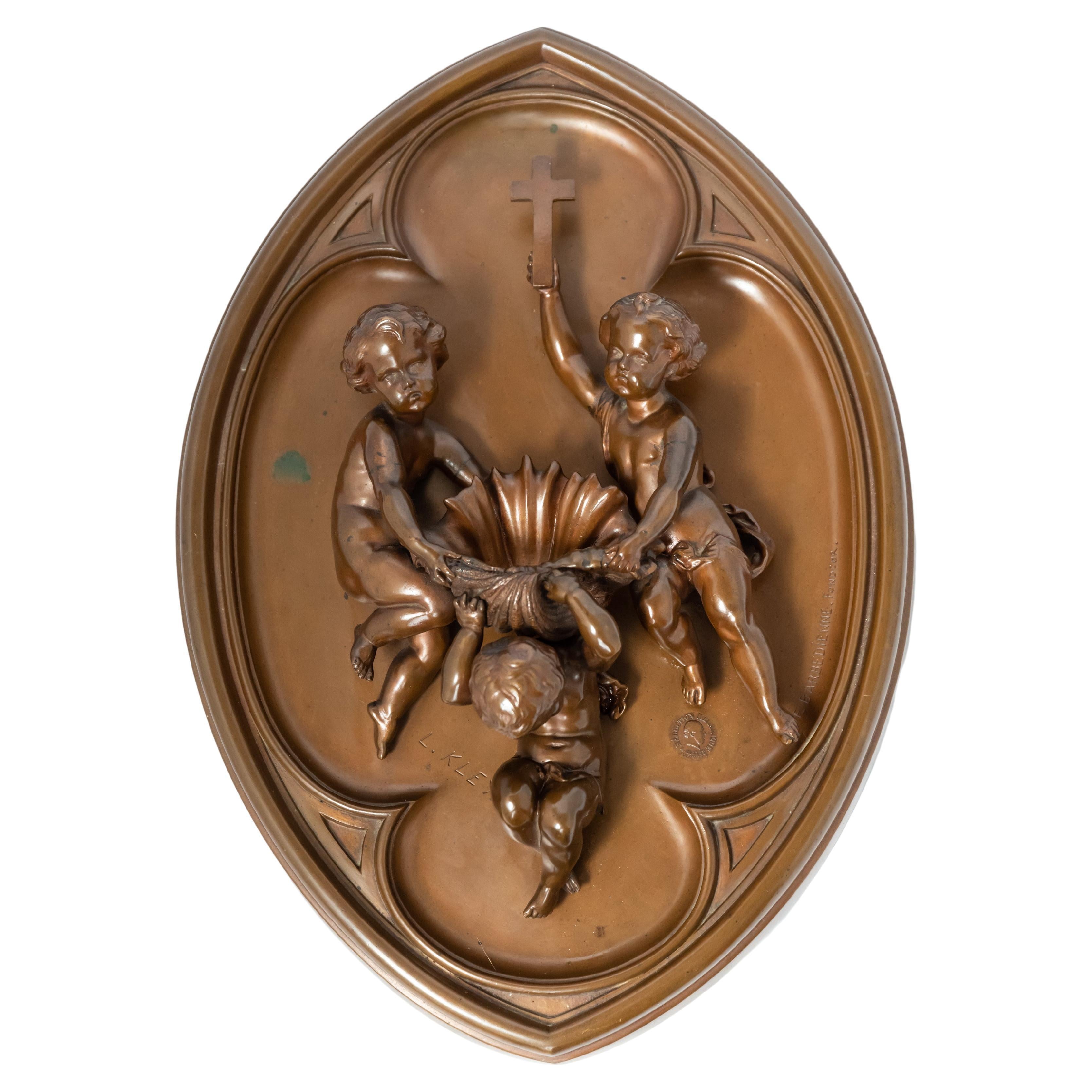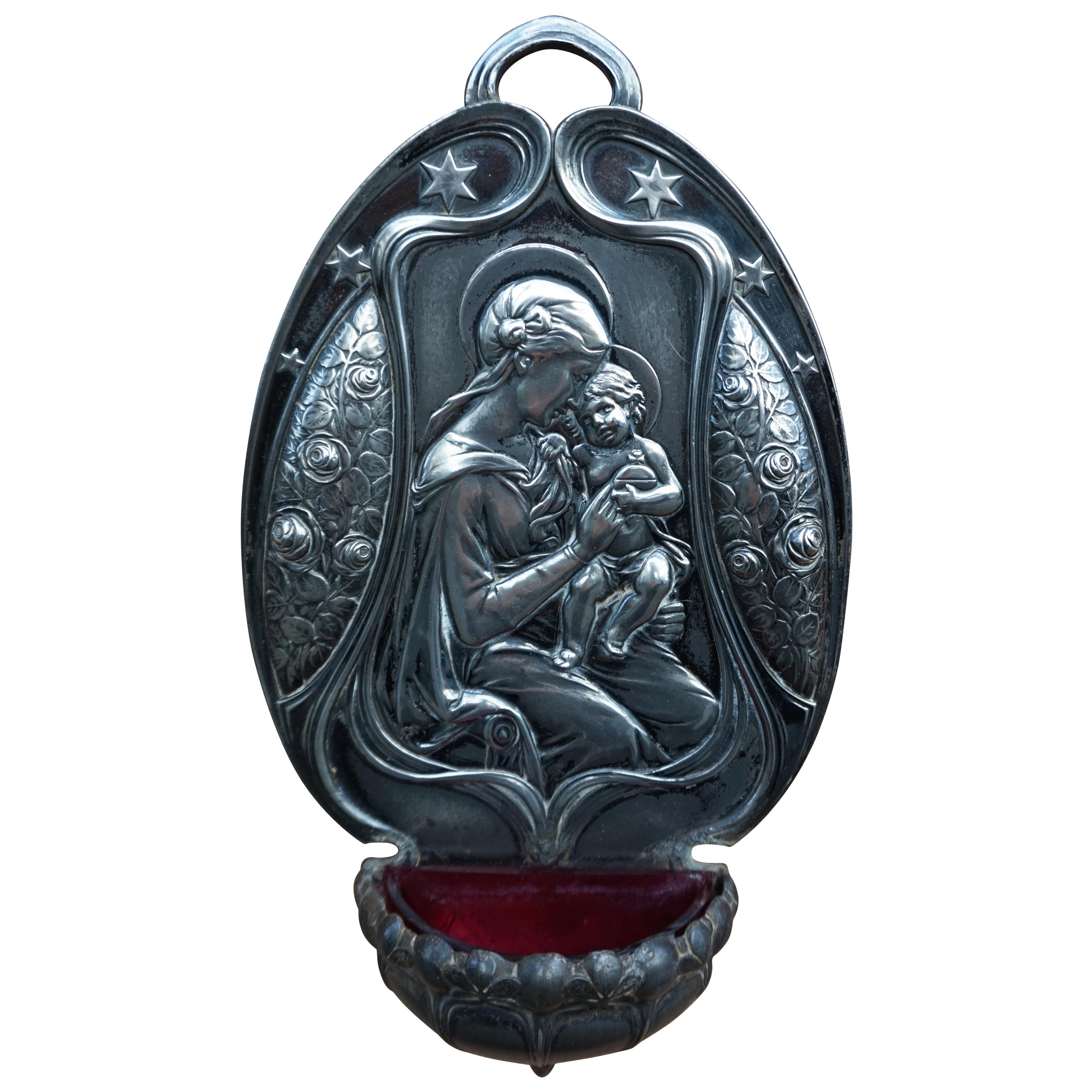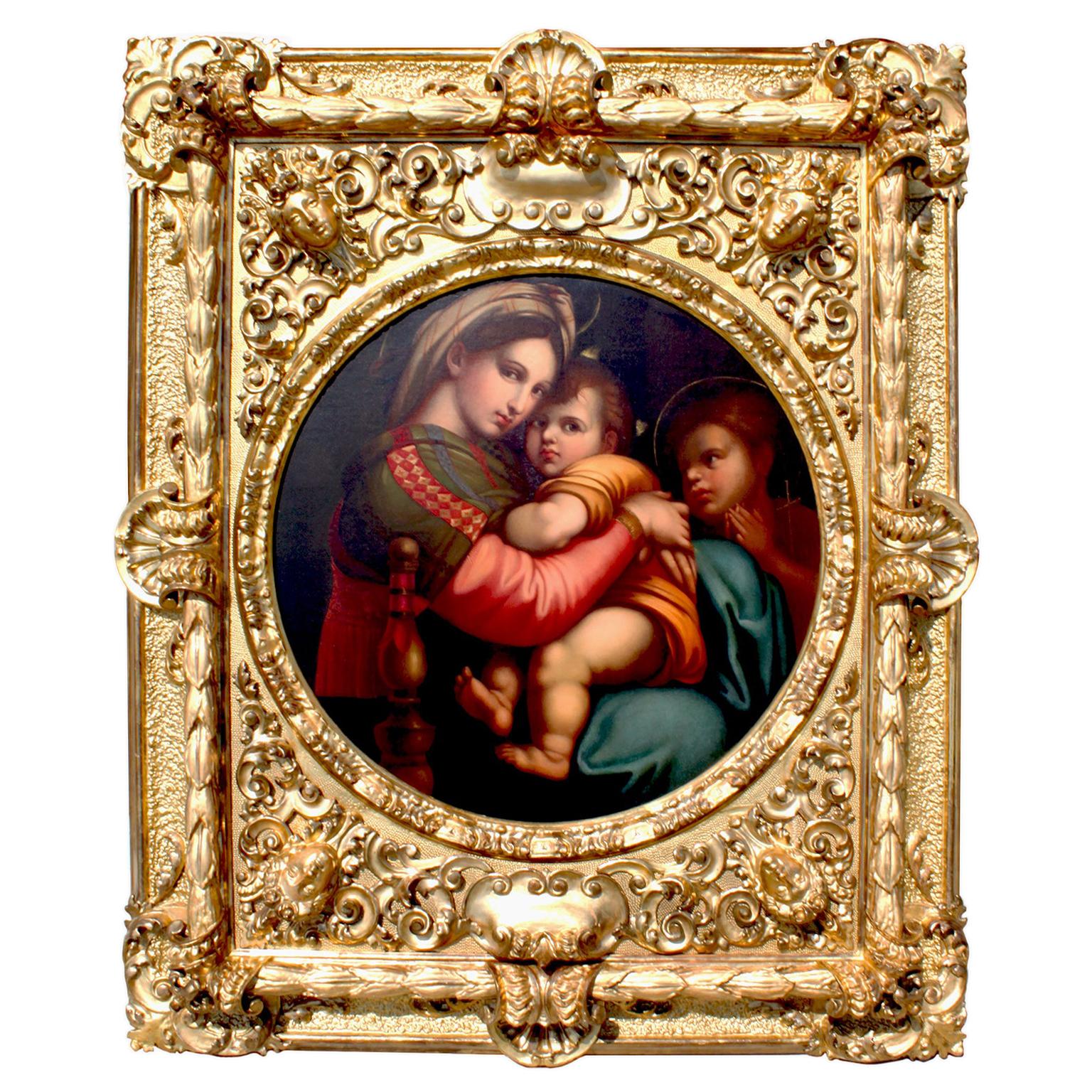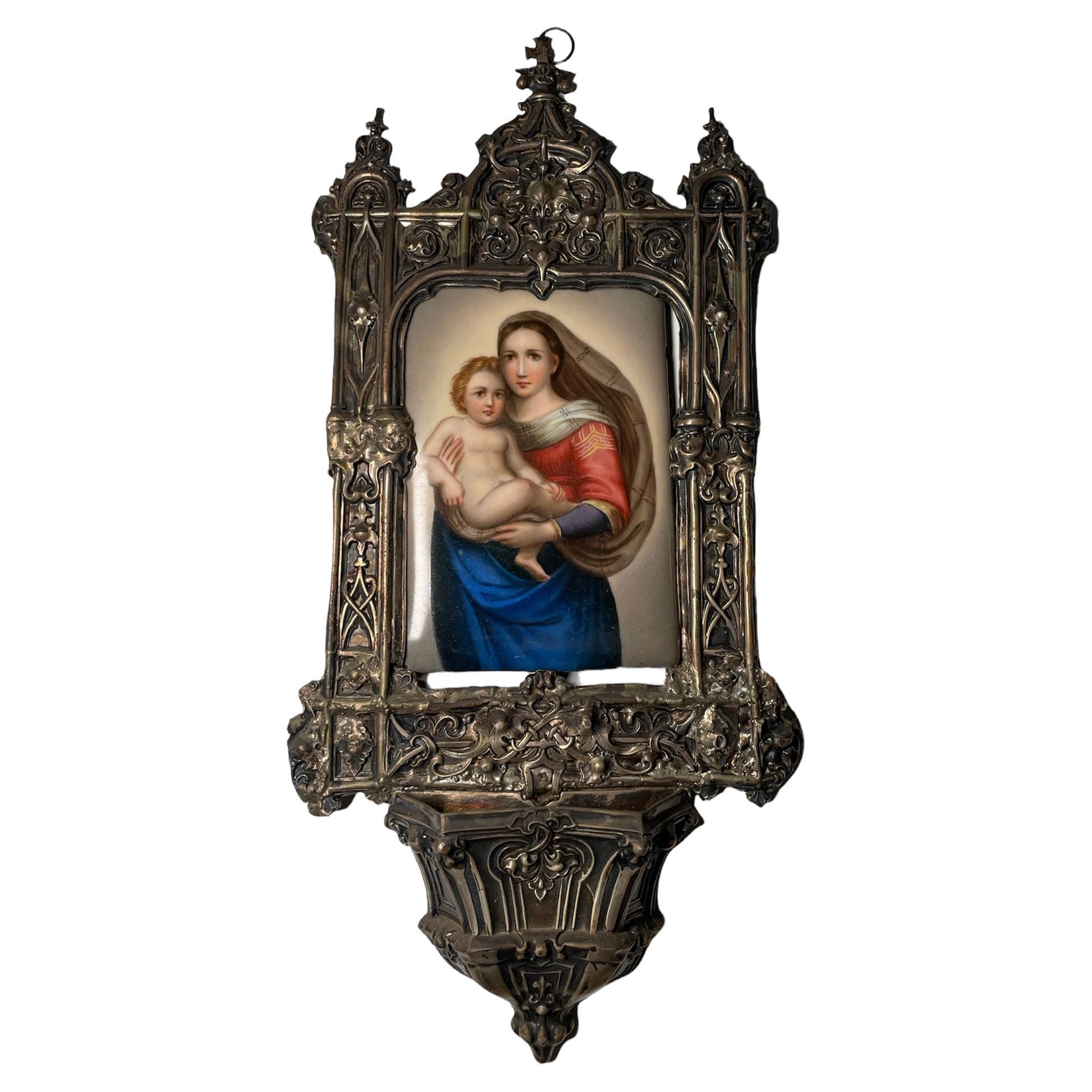Items Similar to Raffaello's Madonna Della Seggiola Bronze & Marble Wall Plaque & Holy Water Font
Want more images or videos?
Request additional images or videos from the seller
1 of 19
Raffaello's Madonna Della Seggiola Bronze & Marble Wall Plaque & Holy Water Font
About the Item
Meaningful and great quality antique, relic bronze and marble wall plaque with holy water font, after the famous painting of Raffaello.
This antique work of religious art from the late 1800s comes with an incredibly detailed, bronze Mary and Child sculpture. This small but very impressive wall plaque is made of bronze and marble and thanks to its great design and details it truly is a joy to own and look at. The superb sculptures stand out particularly well (also from a distance) against the black dark background. The archetype of The Mother caring for her child can be projected to all kinds of situations in which we take care of and/or pray for our loved ones, the vulnerable and the less privileged. By blessing or crossing yourself you can ask for protection for yourself and your loved ones. As a message/gesture from you to your family, children and guests, you could hang this Victorian Era, Christian artefact near your entrance. To us, this unique antique radiates love and positivity and god knows we can do with a lot more of both. This Italian, handmade Gothic relic font would have been from a very well to do family (or church) because a handcrafted, exquisite piece of such expensive materials would have cost a small fortune in those days. Have you also noticed the trefoil design (for the trinity), bronze hook on the back? This too is proof of the quality and the attention to detail in this ecclesiastical work of art.
Because of its profound meaning and incredible workmanship this piece will never go out of style and if you like this rare and superb condition, work of religious art as much as we do then you will love our price. Especially when taking into account that perfect packing and also worldwide delivery from our store to your door in just 4 to 6 days are complimentary.
Maximum height x width x depth: 14.8 x 7.8 x 2.1 inches.
We have a passion for the unique, for quality, for artistic and meaningful and for craftsmanship of years gone by. Your purchases will be extremely well packaged and we look forward to serving you (again).
You can shop all our 1000+ listings by pushing the button that reads 'View All From Seller'.
- Similar to:Raphael (Raffaello Sanzio da Urbino) (Artist)
- Dimensions:Height: 14.8 in (37.6 cm)Width: 7.8 in (19.82 cm)Depth: 2.1 in (5.34 cm)
- Style:Gothic Revival (Of the Period)
- Materials and Techniques:
- Place of Origin:
- Period:
- Date of Manufacture:Late 1800s
- Condition:Wear consistent with age and use. Please also read our item description.
- Seller Location:Lisse, NL
- Reference Number:
About the Seller
5.0
Platinum Seller
These expertly vetted sellers are 1stDibs' most experienced sellers and are rated highest by our customers.
Established in 2000
1stDibs seller since 2016
2,553 sales on 1stDibs
Typical response time: 1 hour
- ShippingRetrieving quote...Ships From: Lisse, Netherlands
- Return PolicyA return for this item may be initiated within 7 days of delivery.
More From This SellerView All
- Antique Icon like Gilt Bronze Mary and Child Jesus Plaque over a Holy Water FontLocated in Lisse, NLMeaningful and perfectly hand-crafted antique church relic. This religious work of art dates from the earliest years of the 20th century and you could not wish for a better condition antique. This finest of holy water font plaques could not be in better condition, but that is also because it was all handcrafted out of the best materials only. Even the hand sawn, square nuts on the back are gilt. And the cross-like hook with the French Gothic fleur-de-lis ends with the ring on top (for easy mounting this gem to your wall) is another detail that shows us that no expense was spared when this antique was hand-crafted all those years ago. Whenever we find religious antiques of this quality and excellent condition, they usually were made for and used in either a church or a monastery (also, because that is where the budget was for the best quality pieces). The quality and the finish of this church relic really is among the best we have ever seen, but the quality of and the details in the sereen Mother Mary...Category
Early 20th Century French Gothic Revival Religious Items
MaterialsBronze
- Jugendstil WMF Marked and Silvered Holy Water Font Depicting Mary & Child JesusBy WMF Württembergische MetallwarenfabrikLocated in Lisse, NLAntique silvered wall font with original and excellent condition glass vessel. This rare Jugendstil wall font by German makers WMF is in excellent condition and it even comes with t...Category
Early 20th Century German Jugendstil Religious Items
MaterialsMetal
- Bronze Gothic Wall Plaque by S. Norga Depicting Mother Mary in Cinquefoil HaloBy Sylvain NorgaLocated in Lisse, NLUnique antique bronze wall plaque by Belgian sculptor Sylvain Norga. This Gothic Revival work of religious art dates from the Art Deco era and it is a little bit of a rare specimen. For some reason, Sylvain Norga almost always created bronze wall plaques of Christ. In some cases he created bronze plaques with both Jesus and Mary in them, but the ones with only Mary are very hard to find. We find it extra special that this stunning and practical size Mother Mary sculpture...Category
Early 20th Century Belgian Gothic Revival Religious Items
MaterialsBronze
- Large Solid Bronze Antique Jugendstil Wall Sculpture Plaque of a Mourning FemaleLocated in Lisse, NLStunning bronze wall plaque with a maker's monogram. In the earliest years of the 1900s much of the daily life in Europe was overshadowed by the horrors of the first world war. Lo...Category
Early 20th Century European Jugendstil Religious Items
MaterialsBronze
- Museum Quality Bronze of Christ Wall Plaque Sculpture "Jesus Carrying the Cross"Located in Lisse, NLStunningly powerful and meaningful work of religious art. With works of religious art being one of our specialties, over the decades we have sold quite a few special antiques in this field. With this bronze antique the artist clearly shows us a fragment out of one of the most famous scenes that took place in the history of mankind. Christ has already been beaten, mocked, given a wreath of thorns and having to carry the enormous cross. As you can see the quality of the details and the workmanship is excellent, but the scene and its meaning ofcourse is even more impressive. Please notice how particularly the facial features reveil the peaceful state of being that lies underneath the exterior of this Christ sculpture...Category
Early 20th Century European Arts and Crafts Religious Items
MaterialsBronze
- Antique Pair of Brass & Bronze Gothic Wall Picture Frames with Saint SculpturesLocated in Lisse, NLFor the collectors of rare and ready to use Gothic antiques. These beautiful and all handcrafted Gothic Revival picture frames with Biblical texts in Latin are an absolute joy to ow...Category
Early 20th Century European Gothic Revival Wall-mounted Sculptures
MaterialsBrass, Bronze
You May Also Like
- A Patinated Bronze Holy Water FontBy F. Barbedienne Foundry, Louis KleyLocated in 263-0031, JPSigned “Kley,” after Louis Kley, a French sculptor (1833-1911). Stamped with the circular “Collas” stamp indicating that the reduction of this cast from the original was performed ac...Category
Antique Late 19th Century French Wall-mounted Sculptures
MaterialsBronze
- After Raffaello Sanzio 1483-1520 Raphael La Madonna della Seggiola Oil on CanvasBy Raphael (Raffaello Sanzio da Urbino)Located in Los Angeles, CAA fine Italian 19th century oil painting on canvas "La Madonna della Seggiola" after Raphael (Raffaello Sanzio da Urbino 1483-1520) The circular canvas depicting a seated Madonna holding an infant Jesus Christ next to a child Saint John the Baptist, all within a massive carved gilt wood and gesso frame (all high quality gilt is original) which is identical to the frame on Raphael's original artwork. This painting is a 19th Century copy of Raphael's Madonna della Seggiola painted in 1514 and currently exhibited and part of the permanent collection at the Palazzo Pitti, Galleria Palatina, Florence, Italy. The bodies of the Virgin, Christ, and the boy Baptist fill the whole picture. The tender, natural looking embrace of the Mother and Child, and the harmonious grouping of the figures in the round, have made this one of Raphael's most popular Madonnas. The isolated chair leg is reminiscent of papal furniture, which has led to the assumption that Leo X himself commissioned the painting, circa 1890-1900. Subject: Religious painting Measures: Canvas height: 29 1/4 inches (74.3 cm) Canvas width: 29 1/4 inches (74.3 cm) Painting diameter: 28 1/4 inches (71.8 cm) Frame height: 57 7/8 inches (147 cm) Frame width: 45 1/2 inches (115.6 cm) Frame depth: 5 1/8 inches (13 cm). Raffaello Sanzio da Urbino (Italian, March 28 or April 6, 1483 - April 6, 1520), known as Raphael, was an Italian painter and architect of the High Renaissance. His work is admired for its clarity of form, ease of composition, and visual achievement of the Neoplatonic ideal of human grandeur. Together with Michelangelo and Leonardo da Vinci, he forms the traditional trinity of great masters of that period. Raphael was enormously productive, running an unusually large workshop and, despite his death at 37, leaving a large body of work. Many of his works are found in the Vatican Palace, where the frescoed Raphael Rooms were the central, and the largest, work of his career. The best known work is The School of Athens in the Vatican Stanza della Segnatura. After his early years in Rome much of his work was executed by his workshop from his drawings, with considerable loss of quality. He was extremely influential in his lifetime, though outside Rome his work was mostly known from his collaborative printmaking. After his death, the influence of his great rival Michelangelo was more widespread until the 18th and 19th centuries, when Raphael's more serene and harmonious qualities were again regarded as the highest models. His career falls naturally into three phases and three styles, first described by Giorgio Vasari: his early years in Umbria, then a period of about four years (1504–1508) absorbing the artistic traditions of Florence, followed by his last hectic and triumphant twelve years in Rome, working for two Popes and their close associates. Raphael was born in the small but artistically significant central Italian city of Urbino in the Marche region, where his father Giovanni Santi was court painter to the Duke. The reputation of the court had been established by Federico III da Montefeltro, a highly successful condottiere who had been created Duke of Urbino by the Pope - Urbino formed part of the Papal States - and who died the year before Raphael was born. The emphasis of Federico's court was rather more literary than artistic, but Giovanni Santi was a poet of sorts as well as a painter, and had written a rhymed chronicle of the life of Federico, and both wrote the texts and produced the decor for masque-like court entertainments. His poem to Federico shows him as keen to show awareness of the most advanced North Italian painters, and Early Netherlandish artists as well. In the very small court of Urbino he was probably more integrated into the central circle of the ruling family than most court painters. Federico was succeeded by his son Guidobaldo da Montefeltro, who married Elisabetta Gonzaga, daughter of the ruler of Mantua, the most brilliant of the smaller Italian courts for both music and the visual arts. Under them, the court continued as a centre for literary culture. Growing up in the circle of this small court gave Raphael the excellent manners and social skills stressed by Vasari. Court life in Urbino at just after this period was to become set as the model of the virtues of the Italian humanist court through Baldassare Castiglione's depiction of it in his classic work The Book of the Courtier, published in 1528. Castiglione moved to Urbino in 1504, when Raphael was no longer based there but frequently visited, and they became good friends. He became close to other regular visitors to the court: Pietro Bibbiena and Pietro Bembo, both later cardinals, were already becoming well known as writers, and would be in Rome during Raphael's period there. Raphael mixed easily in the highest circles throughout his life, one of the factors that tended to give a misleading impression of effortlessness to his career. He did not receive a full humanistic education however; it is unclear how easily he read Latin. Early Life and Works His mother Màgia died in 1491 when Raphael was eight, followed on August 1, 1494 by his father, who had already remarried. Raphael was thus orphaned at eleven; his formal guardian became his only paternal uncle Bartolomeo, a priest, who subsequently engaged in litigation with his stepmother. He probably continued to live with his stepmother when not staying as an apprentice with a master. He had already shown talent, according to Vasari, who says that Raphael had been "a great help to his father". A self-portrait drawing from his teenage years shows his precocity. His father's workshop continued and, probably together with his stepmother, Raphael evidently played a part in managing it from a very early age. In Urbino, he came into contact with the works of Paolo Uccello, previously the court painter (d. 1475), and Luca Signorelli, who until 1498 was based in nearby Città di Castello. According to Vasari, his father placed him in the workshop of the Umbrian master Pietro Perugino as an apprentice "despite the tears of his mother". The evidence of an apprenticeship comes only from Vasari and another source, and has been disputed—eight was very early for an apprenticeship to begin. An alternative theory is that he received at least some training from Timoteo Viti, who acted as court painter in Urbino from 1495.Most modern historians agree that Raphael at least worked as an assistant to Perugino from around 1500; the influence of Perugino on Raphael's early work is very clear: "probably no other pupil of genius has ever absorbed so much of his master's teaching as Raphael did", according to Wölfflin. Vasari wrote that it was impossible to distinguish between their hands at this period, but many modern art historians claim to do better and detect his hand in specific areas of works by Perugino or his workshop. Apart from stylistic closeness, their techniques are very similar as well, for example having paint applied thickly, using an oil varnish medium, in shadows and darker garments, but very thinly on flesh areas. An excess of resin in the varnish often causes cracking of areas of paint in the works of both masters. The Perugino workshop was active in both Perugia and Florence, perhaps maintaining two permanent branches. Raphael is described as a "master", that is to say fully trained, in December 1500. His first documented work was the Baronci altarpiece for the church of Saint Nicholas of Tolentino in Città di Castello, a town halfway between Perugia and Urbino. Evangelista da Pian di Meleto, who had worked for his father, was also named in the commission. It was commissioned in 1500 and finished in 1501; now only some cut sections and a preparatory drawing remain. In the following years he painted works for other churches there, including the Mond Crucifixion (about 1503) and the Brera Wedding of the Virgin (1504), and for Perugia, such as the Oddi Altarpiece. He very probably also visited Florence in this period. These are large works, some in fresco, where Raphael confidently marshals his compositions in the somewhat static style of Perugino. He also painted many small and exquisite cabinet paintings in these years, probably mostly for the connoisseurs in the Urbino court, like the Three Graces and St. Michael, and he began to paint Madonnas and portraits. In 1502 he went to Siena at the invitation of another pupil of Perugino, Pinturicchio, "being a friend of Raphael and knowing him to be a draughtsman of the highest quality" to help with the cartoons, and very likely the designs, for a fresco series in the Piccolomini Library in Siena Cathedral. He was evidently already much in demand even at this early stage in his career. Influence of Florence Raphael led a "nomadic" life, working in various centres in Northern Italy, but spent a good deal of time in Florence, perhaps from about 1504. Although there is traditional reference to a "Florentine period...Category
Antique 19th Century Italian Baroque Paintings
MaterialsGesso, Canvas, Wood
- Wall Brass Holy Water Font Hand Painted Porcelain of the Sistine MadonnaLocated in Guaynabo, PRThis is a hand painted KPM style rectangular plaque of the Sistine Madonna framed in a wall brass holy water font. The brass frame depicts three arcs, two small semicircular in the s...Category
Early 20th Century Unknown Renaissance Decorative Art
MaterialsBrass
- Late 19th Century Bronze Holy Water Font with Angel by Leblanc-BarbedienneBy Leblanc Frères 1Located in Casteren, Noord-BrabantA fine quality antique holy water font for on a wall, made of casted and chiseled bronze. Depicting an angel with a shell as a holy water font. Signed at the backside of the lid, Leb...Category
Antique Late 19th Century French Wall-mounted Sculptures
MaterialsBronze
- Carved Fruitwood Plaque of Virgin and Child Madonna, after Donatello SculptureLocated in West Hollywood, CACarved Fruitwood Plaque of Virgin and Child Madonna, after Donatello Sculpture . A Large Beautifully 18th/19th Century Carved Relief Fruitwood partially gilt of “ MADONNA AND CHILD”...Category
Antique 18th Century Italian Wall-mounted Sculptures
MaterialsWood, Giltwood
- English Oversized Wooden Tennis Racket Wall PlaqueLocated in New York, NYEnglish (1920's) oversized wooden tennis racket wall plaque. (stamps: G & T LONDON/CHAMPION EXTRA LIGHT).Category
Vintage 1920s English Sports Equipment and Memorabilia
MaterialsString, Wood
Recently Viewed
View AllMore Ways To Browse
Marble Church Font
Marble Holy Water Font
Marble Water Font
Ethiopian Coptic
Pax Board
Polish Kiddush Cup
Prayer Kneeler Bench
Standing Crucifix
Synagogue Lamp
Torah Shield
Vintage Hannukah
Virgin Plaster Statue
Antique Mezuzah
Bible Stand Altar
Gothic Revival Bible Stand
Italian Gothic Reliquary
Tibetan Manuscript
Crucifix Holy Water




